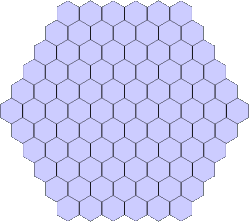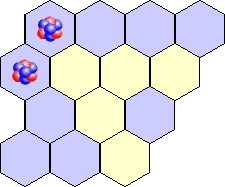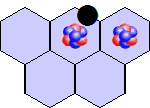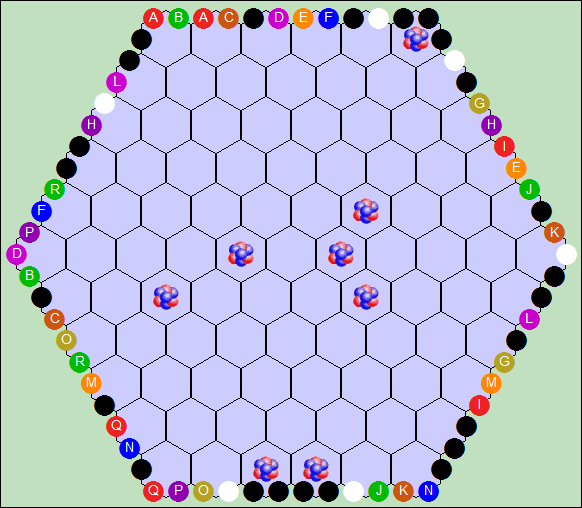 The Rutherford playing board
The Rutherford playing board
Rutherford is a game of logical deduction where players try to discover the location of several "atoms" hidden within a grid. The atoms cannot be directly observed, but they interact with "rays" fired into the grid from the edges. By choosing where to fire rays into the grid and carefully observing where each ray exist, the player can deduce the positions of the atoms.
Rays can be fired into any of the exposed edges of the grid. Each firing will have one of three distinct results: the ray will exit the grid at the same place it entered (called a REFLECTION), the ray will exit the grid at a different spot (called a DEFLECTION), or the ray will not exit the grid at all (called an ABSORBTION).
The player fires as many rays as he deems necessary into the grid from any locations of his choosing, until he is confident of the location of all of the hidden atoms. A score is then determined based on the number of rays used and a penalty for each atom guessed incorrectly.
Behavior of Rays

The simplest ray result is an ABSORBTION. This occurs when the ray directly impacts an atom, as shown in the diagram to the right. The yellow hexes represent the path of the ray, which was fired into the grid from the upper-right edge. The ray is absorbed by the atom and so does not emerge from the grid at any point.

If a ray does not directly impact an atom but merely passes near it, the result is a DEFLECTION. In the diagram to the right the yellow hexes show the path of a ray being deflected by a single atom. The path is bent by 60 degrees as it passes through the hex adjacent to the atom. Note that it doesn't matter which direction the ray is traveling; the path will be identical whether it entered at the top and emerged at the right or vice versa. This symmetry always holds true for deflections -- the entry and exit points are always interchangeable.

A greater deflection angle occurs if the ray interacts with two adjacent atoms as shown in the diagram to the right. In this case the path of the ray is bent 120 degrees instead of 60. This is the greatest deflection that can occur, as there is no way for a ray to interact with more than two atoms simultaneously. Again the path is fully symettrical so that the entry and exit points are interchangeable.

Under certain circumstances a ray's path may be altered in such a way that it exits from the same point from which it entered, resulting in a REFLECTION. One way this can occur is shown in the diagram to the right. The ray (entering from the left) encounters two atoms simultaneously, either of which would normally deflect the ray to further to the side. Together they force the ray to return the way it came, essentially acting as a mirror.
Marking Rays
Rays are marked by placing a colored dot on the edge where they enter and, if necessary, where they exit. A black dot indicates that the ray was absorbed, a white dot indicates the ray was reflected, and assorted other colors are used for deflections. In the case of a deflection, the dot is also labeled with an identifying letter and an identical dot (with identical label) is placed at the exit point. This makes it easy to find exactly where the ray entered and exited the grid even if other rays have been fired in the meantime.
 Example markings for absorbed rays |
 Example marking for reflected ray |
 Example markings for deflected ray |
Atoms on the Side

An atom on a side of the grid presents a special case for rays fired into the edge directly neighboring the hex containing the atom. A ray entering there will be deflected by the atom, but because the ray is already at the edge of the grid it will immediately exit resulting in a reflection. The diagram to the right shows where this will happen for a single atom against the side. Note that a ray fired directly into the hex containing the atom will still result in absorbtion.

Also note that if a second atom is present it slightly alters the behavior. As shown at the right, a ray that would have been a reflection if only the atom on the right were present is now an absorbtion because it is directly entering a hex containing an atom.
A Complete Example
Carefully study the following diagram which shows an entire playing grid with atoms visible and markers indicating all possible rays. Take a look at the absorbtions and reflections first and make sure you understand how they work. Then follow the deflections from end to end and verify that you can predict the path they follow.
 << Back to Game Page
<< Back to Game Page
